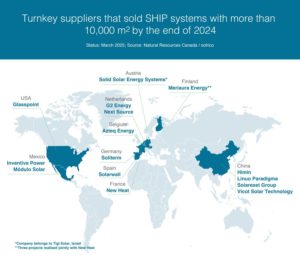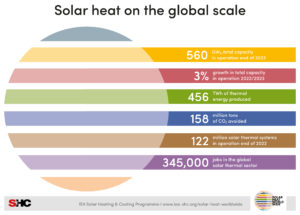SMEThermal 2014: “Take the risk away from the customer and the financier”
March 4, 2014
 Solar thermal is not just about technology, it´s also about financing. It takes much more than just an improved, mature technology to have a successful industry. It needs new business models which attract the financial sector and it requires transparency in terms of performance and costs when dealing with commercial clients. These were the major topics of a roundtable discussion at SMEThermal 2014 in Berlin, Germany, on 18 February 2014. Solar thermal specialists from three different continents – Europe, Asia and North America – presented their case studies at the conference (from left): Søren Elisiussen, CEO of Arcon Solar (Denmark), Nicholas Atkins, Managing Partner of Georgieff Capital Advisors (United Kingdom), Thippegowda Srinath, Technical Director at Emmvee Solar Systems (India), Justin Schafer, Product Manager at Skyline Innovations (USA) and Robin Welling, Managing Director of Tisun (Austria). The roundtable discussion was chaired by Bärbel Epp, Managing Director of solrico (Germany).
Solar thermal is not just about technology, it´s also about financing. It takes much more than just an improved, mature technology to have a successful industry. It needs new business models which attract the financial sector and it requires transparency in terms of performance and costs when dealing with commercial clients. These were the major topics of a roundtable discussion at SMEThermal 2014 in Berlin, Germany, on 18 February 2014. Solar thermal specialists from three different continents – Europe, Asia and North America – presented their case studies at the conference (from left): Søren Elisiussen, CEO of Arcon Solar (Denmark), Nicholas Atkins, Managing Partner of Georgieff Capital Advisors (United Kingdom), Thippegowda Srinath, Technical Director at Emmvee Solar Systems (India), Justin Schafer, Product Manager at Skyline Innovations (USA) and Robin Welling, Managing Director of Tisun (Austria). The roundtable discussion was chaired by Bärbel Epp, Managing Director of solrico (Germany). Photos: Stephanie Banse
Belgium: “We should be a lot more transparent about performance and costs”
Keynote speaker Uwe Trenkner awakened the audience: “We should be a lot more transparent about the performance we are achieving and about the costs of solar heat we are delivering – especially with commercial clients.” The consultant based in Brussels criticised that “if we are to quantify the number of kilowatt hours produced, we would have a problem. We attach so many footnotes about when these figures apply, how this should work and what could go wrong with it, so that the numbers become irrelevant.” Potential clients might just shake their heads in disbelief and buy a heat pump instead.
USA: “We want to make use of solar thermal as easy for small enterprises as possible”
Justin Schafer, Product Manager at Skyline Innovations provoked the audience in the same way by starting his statement with: “Nobody cares about you, nobody at all! People are not aware of solar thermal, they do not see the benefits and they do not see why it is relevant to them.” Afterwards, the product manager emphasised that “we want to make the use of solar thermal as easy for small enterprises as possible” and explained Skyline’s business model, which combines the services of an Energy Service Company (ESCO) with a price-indexed heat supply. “To make this as appealing as possible, we do not only pay for the entire investment, but we also want to shift all the risk from the consumer to ourselves, that means that we charge our clients for any solar unit between 25 and 50% less than what they have to pay to the utility for the conventional energy they purchase.” That this business model is successful shows the rapid growth of Skyline Innovations, which has already completed 104 ESCO projects since the foundation of the company in 2010. According to Schafer, 96 systems were in the design/build phase and another 41 had been commissioned (for more information, see the interview with Justin Schafer).
When having been asked whether Skyline’s business model is exportable, Schafer pointed out that “it can work in additional markets, especially with high energy prices, but then the key issue is to bring down equipment and installation costs.”
“I can imagine that the ESCO model works for very large installations in Europe,” Robin Welling, CEO of Tisun, added. “However, as a solar system manufacturer, I should not mix up business models. ESCO services are associated with a completely different rhythm and need very different staff qualifications.”
Denmark: “It is absolutely crucial to drive down costs”
Elisiussen agreed that ESCO models “sound logical and might be a way forward for large installations,” but right now, the CEO of Danish company Arcon doesn’t see the demand for ESCO services at home. His company has delivered some of the largest solar district heating systems in Europe over the last years, which are all owned and operated by municipalities. “These municipalities have access to very attractive funding with low-interest loans of 3% over 20 to 25 years, so no need for ESCO services.” Because of the high competition, it had been absolutely crucial for Arcon to drive down costs. “We have improved the cost/performance ratio over the last 5 years by around 50%,” the CEO said (for more information on his business models, see the case study).
What about exporting the Danish business model to other countries with large district heating plants? “Absolutely possible,” Welling confirmed. “If it works in Denmark, it would probably work in Hungary and Ukraine as well. And there are actually very technical platforms in these countries.”
India: Solar heat costs half the price of hot water produced by electricity
“For the moment, ESCOs are no model for us, as we have a problem with the metering,” Srinath Thippegowda said. The Technical Director at Emmvee Solar Systems confirmed that short-term payback times were the key argument for most investment decisions in India, even though some companies and institutions were open to much deeper financial analyses. “This shows a positive trend,” Srinath said and recalled a recent case. “Originally, the Symbiosis Institute of Business Management in the city of Hyderabad wanted to install electric heaters for the hot water needs of the student hostel,” Srinath explained. “However, after a rough calculation and a couple of visits, they were convinced, because they understood that solar will save them a lot of money.” With 3.2 INR/kWhth (39 EUR/MW), the price for solar heat over 10 years is less than half the price of hot water produced by electricity with 6.7 INR/kWhth (82 EUR/MWh) (see the respective news piece for more information about this case study). So, solar thermal is a very cost-effective solution in a country with fairly high energy prices – in India as well as in many other countries worldwide. It is a good message which should be spread among potential clients elsewhere.
“Make solar thermal an easy and adaptable technology for our customers. It is on us, the leaders in a small industry, to take the risks away from the customer and the financier. Take the risk on us, the experts, because we understand what we are doing,” was the final takeaway by Justin Schafer for the European audience.
More information:


